As I’ve mentioned before, the comments section of the Hardball Times is a barren wasteland. But Matt Swartz’s latest treatise on being an idiot with a stats software package attracted some controversy, mostly because he’s an idiot with a stats software package. I’ve archived the SABR fight in case the comments disappear as things sometimes do on THT. And I’ve even highlighted the best parts.
Mike Fast:
The community has shown with certainty that there is little difference between pitchers? I would say that my study of HITf/x data indicated exactly the opposite.
And similarly for team defensive efficiency, a large portion of it is due to how hard the team’s pitchers allow the ball to be hit.
Single-year BABIP is a crude measure of pitcher skill, and it’s leading you to conclusions about the game of baseball that are very wrong.
Matt Swartz:
I’m not coming to any wrong conclusions. I don’t know what you think I’m doing with single season BABIP, but it’s not leading myself to wrong conclusions.
There IS little difference relative to the difference between pitchers in strikeout rate, which is why it takes more than a season to stabilize.
What your study showed was that how hard balls are hit is persistent, and that it is correlated with BABIP. It didn’t widen the spread of pitcher BABIP skill levels in the MLB, which is and always has been minimal compared to the spread in strikeout rates.
I find your comment about “leading you to conclusions about the game of baseball that are very wrong” to be fantastically indicative that you haven’t really read and understood this or anything else I’ve written on the topic of pitcher BABIP. If you did, you could certainly understand your own findings better, and you’d know they aren’t contradictory.
The reason that single season BABIP is a crude indicator of pitcher skill is sample size. The variance in an individual’s BABIP skill level due to randomness is going to be about [.21/sqrt(number of batted balls)]. Knowing this, we can actually pin down that about 75% of single season BABIP variance is due to luck for pitchers with >=150 IP. The rest of it comes down to know the other 25%. We know that regressing team BABIP by the same process would yield another 13% of the variance in BABIP, which means that there is 12% for pitching.
Using single season BABIP to understand that 12% will due a pretty poor job. However, using peripherals and running a regression as I have will eliminate a lot of that noise. In fact, you can explain about 10.4% of that 12% by knowing peripherals. What your study likely did is duplicated some of the effort in understanding the first 10.4% (hard hit balls or correlated with peripherals; check your data, I’m sure it’s true) and supplemented a good portion of the remaining 1.6%.
In other words, nothing you found negates anything I’ve found at all. You’ve come up with a way to use propietary data effectively. Unless you have that available, using peripherals does a pretty good job. I can’t even imagine what it is that you disagree with here, or what you think I don’t understand.
MF:
I’m not disputing your statistics. I’m disputing your conclusions about the game of baseball.
“What your study showed was that how hard balls are hit is persistent, and that it is correlated with BABIP. It didn’t widen the spread of pitcher BABIP skill levels in the MLB, which is and always has been minimal compared to the spread in strikeout rates.”
Right. But I did show that BABIP is a poor way to measure pitcher skill. We sorta knew that already, but some people had taken the BABIP findings to mean that pitcher skill was also minimal. I established that that conclusion from the evidence was wrong.
You are correct that strikeout rate picks up some of the hard-hit ball skill that pitchers have. However, it does not pick up nearly all of it.
Moreover, batted ball categories are pretty good at picking up vertical launch angle effects, but they are lousy at picking up how hard the ball is it.
So your regressions are still missing some pretty important data.
Yes, the ways we have found to measure that data so far are proprietary. That doesn’t mean that we shouldn’t learn about the reality of baseball from that data and let that effect how we frame questions, though. I would certainly wonder why BABIP doesn’t better reflect how hard the ball is hit.
I found that almost half of team BABIP was due to how hard the ball was hit. So when you say it’s 12 percent pitching skill, that’s what I’m disputing. You could say that you can only detect that 12 percent of the team BABIP is due to the pitchers, but it’s a leap of logic to say that you’re looking at pitching SKILL there. And HITf/x data indicates in fact that you are not.
Also, I don’t understand why you insist on looking at single-season pitcher/team BABIP to determine that number. It is simpler to calculate, but it’s deceptive. Being rooted to single-season numbers is one of the big failings of modern sabermetrics.
MS:
Which of my conclusions about the game of baseball do you dispute?
You found that how hard a ball is hit is highly correlated. This is a self-contained statistic that is only useful inasmuch as it can teach you about singles, doubles, triples, home runs, outs, and errors. It doesn’t do me any good to know the statistic otherwise, except for how it relates to outcomes that affect games. So BABIP is a logical skill to try to infer from how hard a ball is hit, and your numbers do a nice job of hitting on that.
I think when you say “half of BABIP was due to how hard the ball was hit,” you’re either using same year data or R instead of R^2 or doing both. I’m guessing you’re doing correlations, while I’m doing R^2.
But if it’s just same year data, you’re including luck in terms of how hard a ball was hit (of course pitchers will deviate around their true talent rate in this category as well). That doesn’t measure skill. That measures outcomes.
My regressions are not intended to be the end-all summary of a pitcher’s true BABIP skill. They pick up about 80% of the possible variance that could exist in BABIP skills.
Since this seems to be a point of contention—how much variance in true BABIP skill there is to find—I’ll prove to you that R=0.5 or even R^2=.25 is insane for one season of data.
Take all pitchers with 150 IP or more in a single season from 2003-2011. They average 592 BIP. There true BABIP skill is about .30, give or take, so the variance in luck HAS to be .21/592 for the average pitcher in this group. It’s impossible binomially for that not to be true. That’s a random variance if .000354. The actual variance in BABIP for that same group is .000457. That means randomness HAS to explain 77% (last time I got 75% but same diff)! I don’t know how much you think is team defense, but you’re it’s not 0%. If you look at how much variance is explainable by defense seriously, it’s about 13%. That’s just regressing the data.
So my original 12% number is the maximum explainable by differences between pitchers. That’s not what my regressioun found. That was 10.4%. Obviously give or take here or there, but you get the point. Most of it is explained by peripherals.
And just because you’re saying I’m looking at single-season numbers to prove that point, that has nothing to do with the implications of that 12%. The 12% means the standard deviation is pitcher skill is about .007 of BABIP. It can’t be much greater than that, and it has nothing to do with choosing a single season. The same analysis on careers or half seasons or whatever would give you about the same conclusion. I look at single-season because it’s the easiest to run these tests on quickly.
So what exactly do you think are my wrong conclusions? Where in that description of variance will you determine that BABIP skill level has a higher spread than about .007, and where as about .005 or .006 can be explained by a regression on peripherals, tell me what’s wrong here. If you want to say there is value in the last .001 or .002, great, keep at it. It may only be attainable with propietary data, and good for you if you can use it to your advantage. But nothing that I have found here is wrong.
And there it ends, without even a snide remark from Fast on Twitter. I feel like Matt Swartz took Nate Silver’s Baseball Prospectus columns a little too much to heart.


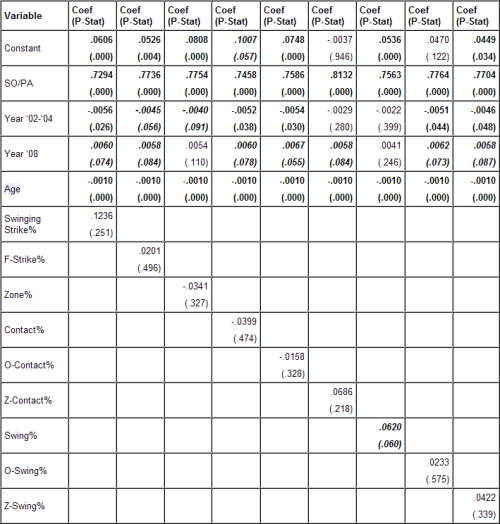
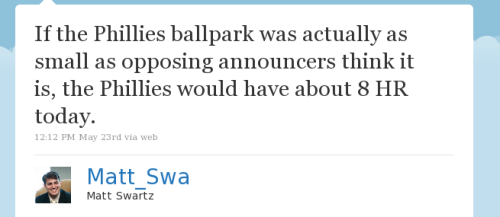
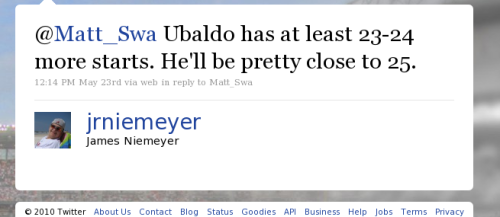


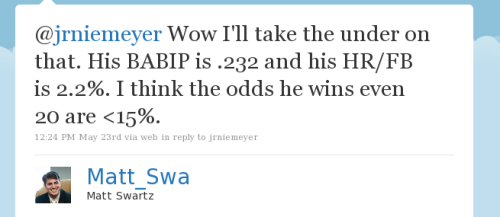
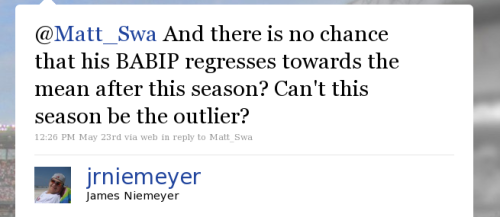
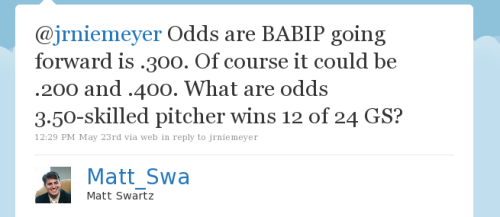
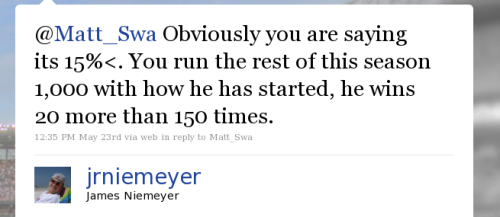
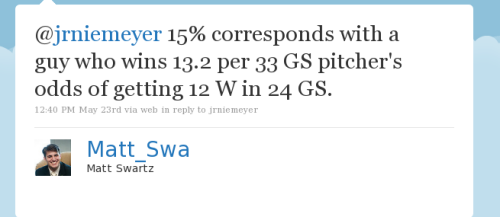
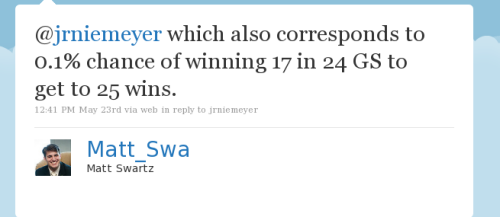

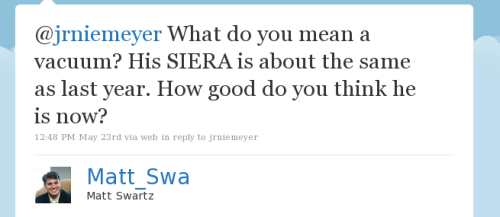

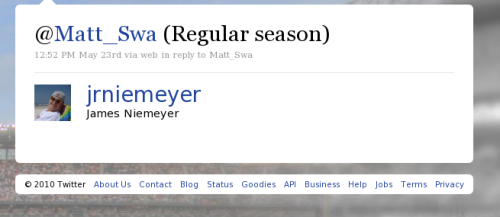

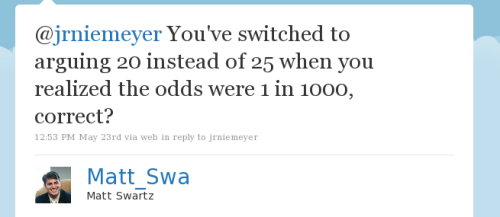
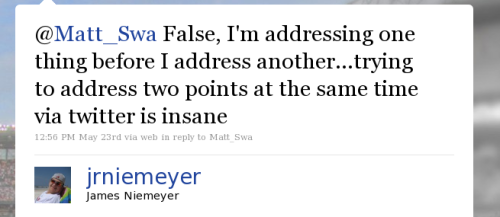


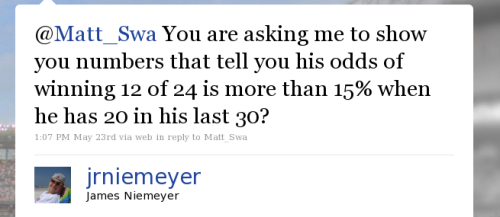
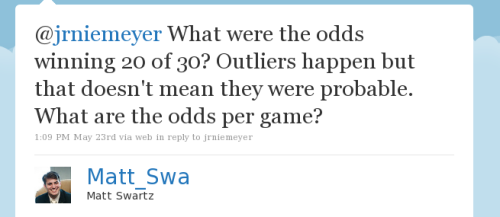

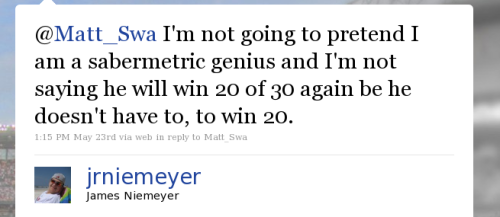
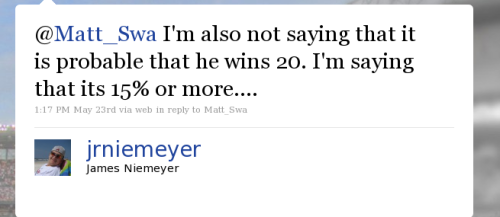
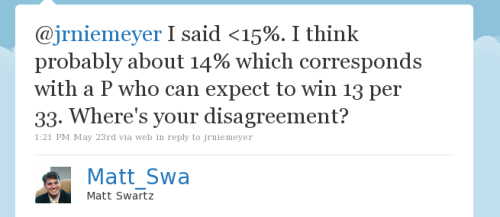
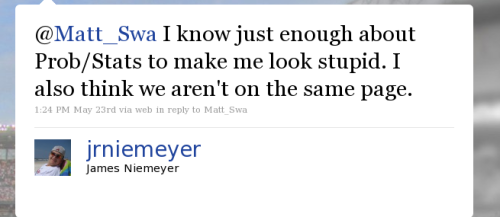

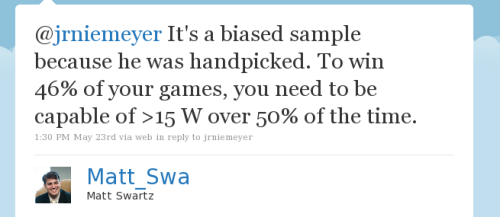

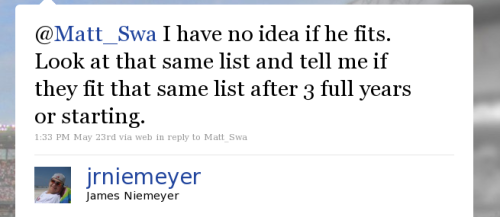


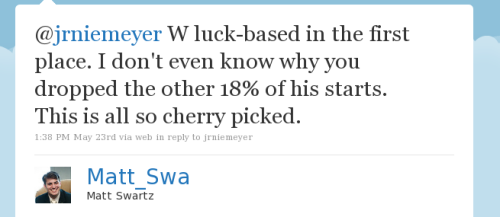
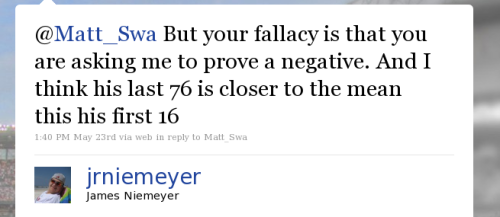
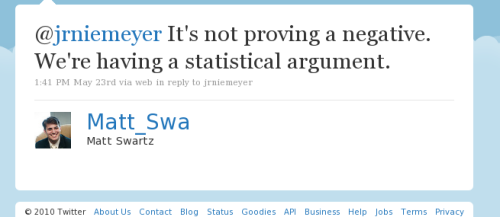
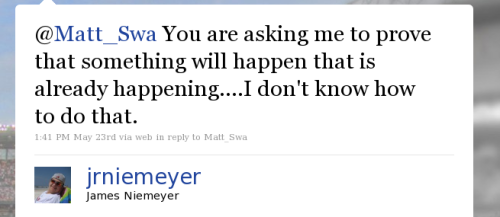
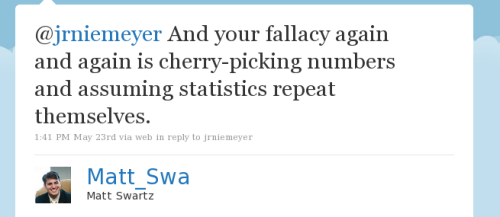
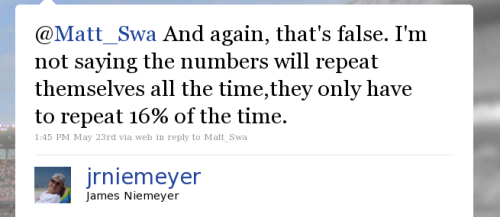


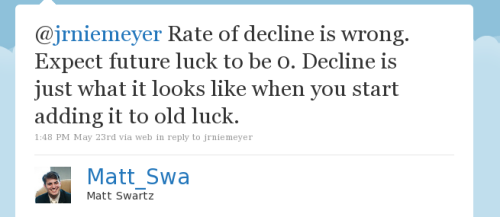


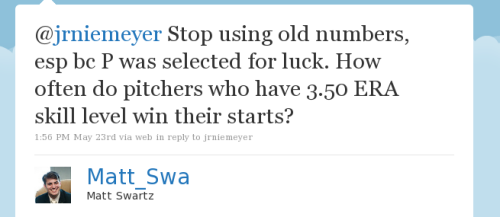
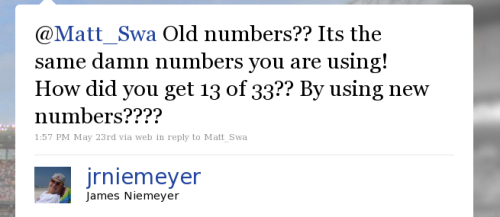


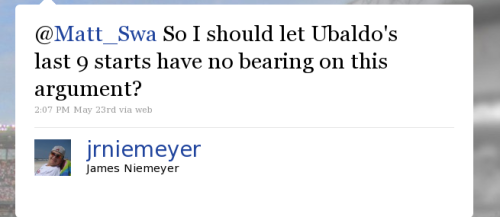
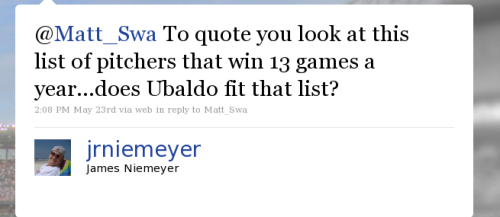

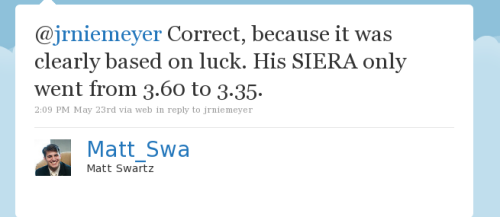



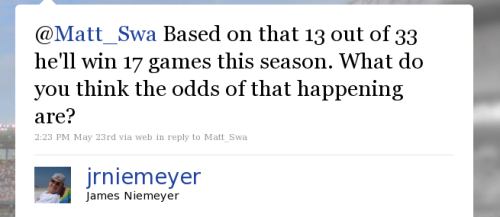

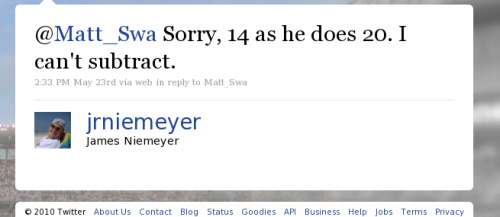

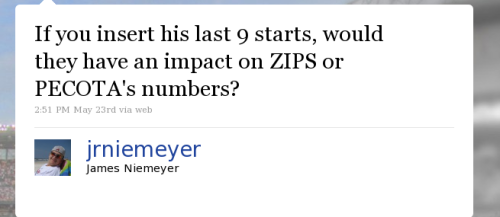

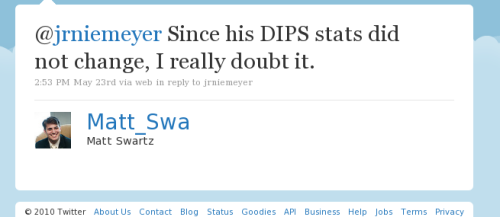
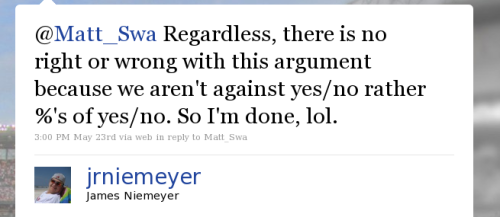

You’re Wrong; No, You Are!
As I’ve mentioned before, the comments section of the Hardball Times is a barren wasteland. But Matt Swartz’s latest treatise on being an idiot with a stats software package attracted some controversy, mostly because he’s an idiot with a stats software package. I’ve archived the SABR fight in case the comments disappear as things sometimes do on THT. And I’ve even highlighted the best parts.
Mike Fast:
Matt Swartz:
MF:
MS:
And there it ends, without even a snide remark from Fast on Twitter. I feel like Matt Swartz took Nate Silver’s Baseball Prospectus columns a little too much to heart.
Leave a comment
Posted in Articles
Tagged comments war, hardball times, insults, matt swartz, mike fast